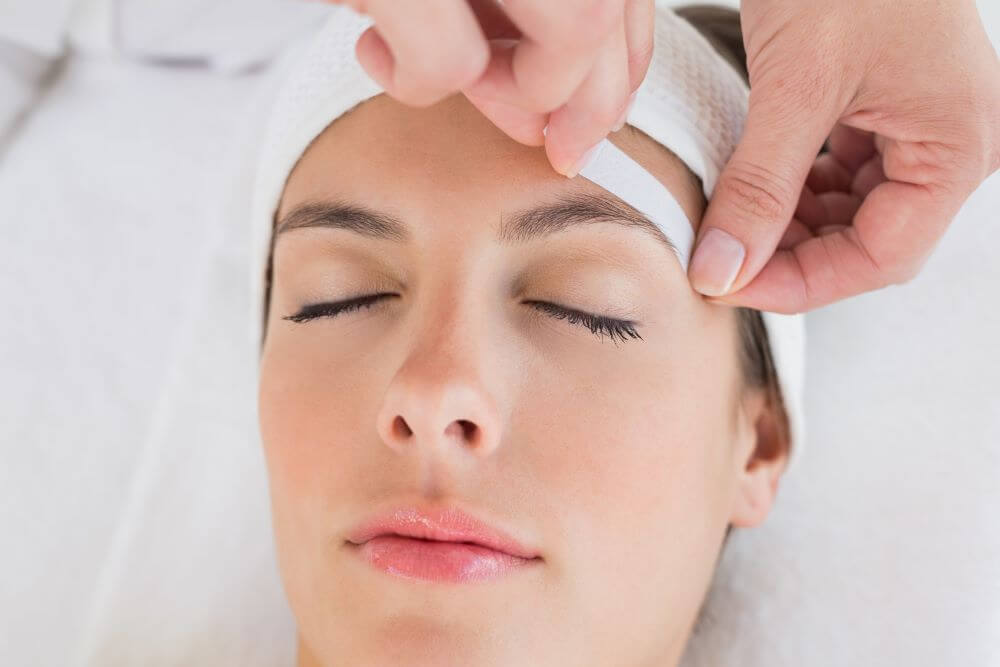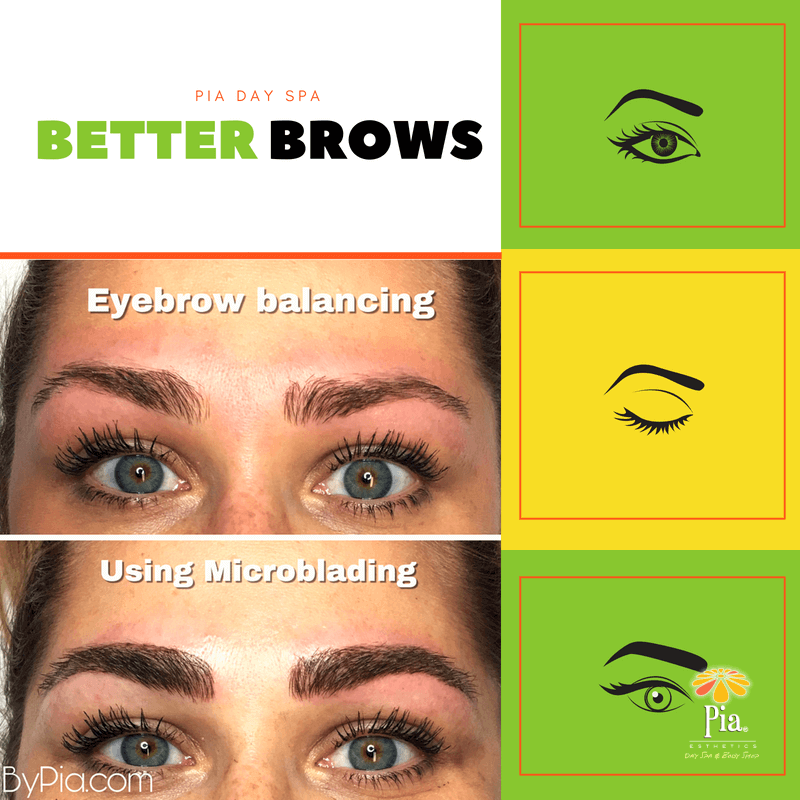When embarking on the journey of waxing or any other type of hair removal, understanding the various techniques and identifying the best method for one's personal goals and needs is a vital first step. Hair removal, at its essence, involves the process of eliminating unwanted body hair, with techniques that vary widely in methodology, duration of results, and suitability for different skin and hair types.
Waxing
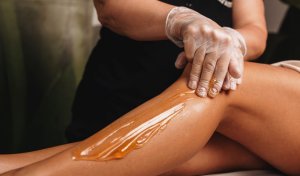 Waxing stands out as a favored method for achieving silky, hair-free skin that lasts for weeks. Yet, embarking on this journey requires thoughtful consideration. Regardless of whether you're targeting a small section like the eyebrows or upper lip or opting for waxing larger areas such as the legs or bikini line, preparation is key to reducing discomfort and maximizing outcomes.
Waxing stands out as a favored method for achieving silky, hair-free skin that lasts for weeks. Yet, embarking on this journey requires thoughtful consideration. Regardless of whether you're targeting a small section like the eyebrows or upper lip or opting for waxing larger areas such as the legs or bikini line, preparation is key to reducing discomfort and maximizing outcomes.
Choosing a Reputable Waxing Provider is Essential. Securing a waxing appointment means more than just marking your calendar; it involves selecting a reputable professional to conduct the service. This step is pivotal in attaining the smooth, radiant skin you desire. Moreover, keeping the advice and information provided here in mind will contribute to a successful waxing experience, yielding the results you aim for. Being well-informed is your strongest asset in preparing for your forthcoming waxing session.
Shaving
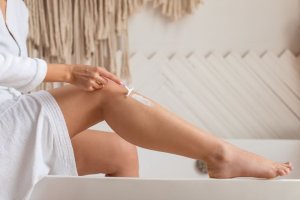 Shaving is one of the most common removal methods, offering a convenient and pain-free solution. It involves using a razor to cut the hair at the skin's surface. One of the key advantages of shaving is the speed and simplicity of the process. It can be done at home with minimal equipment and offers immediate results. However, the results are short-lived, as it typically begins to regrow within a day or two, leading to potential issues such as stubble or razor burn. Shaving is best suited for those looking for a quick and temporary fix, and it's widely applicable to most body areas.
Shaving is one of the most common removal methods, offering a convenient and pain-free solution. It involves using a razor to cut the hair at the skin's surface. One of the key advantages of shaving is the speed and simplicity of the process. It can be done at home with minimal equipment and offers immediate results. However, the results are short-lived, as it typically begins to regrow within a day or two, leading to potential issues such as stubble or razor burn. Shaving is best suited for those looking for a quick and temporary fix, and it's widely applicable to most body areas.
Depilatory Creams
 Another popular option is depilatory creams, which break down the structure of the hair, allowing it to be easily wiped away. These creams can provide results that last slightly longer than shaving, as the hair is dissolved slightly below the surface of the skin. The creams are generally easy to use and can be applied to large areas without much effort. A consideration, however, is that they contain chemicals that can cause skin irritation or allergic reactions in some individuals, so a patch test is advisable before full application. Depilatory creams are a feasible choice for those who prefer a pain-free method without the potential for nicks or cuts that come with a razor.
Another popular option is depilatory creams, which break down the structure of the hair, allowing it to be easily wiped away. These creams can provide results that last slightly longer than shaving, as the hair is dissolved slightly below the surface of the skin. The creams are generally easy to use and can be applied to large areas without much effort. A consideration, however, is that they contain chemicals that can cause skin irritation or allergic reactions in some individuals, so a patch test is advisable before full application. Depilatory creams are a feasible choice for those who prefer a pain-free method without the potential for nicks or cuts that come with a razor.
Epilation
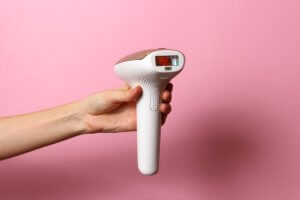 Epilation is a technique that removes hair from the root using an electrical device known as an epilator. The device grasps multiple hairs at once and pulls them out. The advantage of epilation is the length of time it takes to regrow, which can be several weeks, leading to a longer-lasting smoothness compared to surface-level methods. The downside, though, is that it can be quite painful, especially for those with sensitive skin or low pain tolerance. It's important to note that with repeated use, the discomfort typically lessens, and hair may grow back finer over time.
Epilation is a technique that removes hair from the root using an electrical device known as an epilator. The device grasps multiple hairs at once and pulls them out. The advantage of epilation is the length of time it takes to regrow, which can be several weeks, leading to a longer-lasting smoothness compared to surface-level methods. The downside, though, is that it can be quite painful, especially for those with sensitive skin or low pain tolerance. It's important to note that with repeated use, the discomfort typically lessens, and hair may grow back finer over time.
Thread Plucking
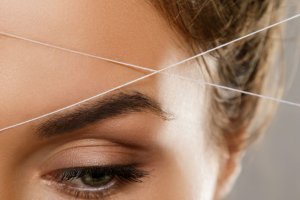 Threading is an ancient method that involves using twisted cotton threads to catch and pull out hairs from the follicle. It is especially common for facial hair and offers precision that is beneficial for shaping eyebrows. Threading can provide results lasting up to six weeks. It's particularly suitable for those with sensitive skin who might react adversely to chemical methods or waxing. However, threading can be moderately uncomfortable and requires skill, so it's often best performed by a professional.
Threading is an ancient method that involves using twisted cotton threads to catch and pull out hairs from the follicle. It is especially common for facial hair and offers precision that is beneficial for shaping eyebrows. Threading can provide results lasting up to six weeks. It's particularly suitable for those with sensitive skin who might react adversely to chemical methods or waxing. However, threading can be moderately uncomfortable and requires skill, so it's often best performed by a professional.
Using Light and Lasers
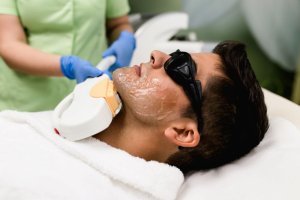 Light-based removal methods, such as intense pulsed light (IPL) and laser, are designed to target the melanin in the hair and disrupt the growth cycle, often leading to permanent reduction. These methods typically require multiple sessions but can offer lasting results and a significant reduction in growth over time. They are a higher-cost investment and might not be effective for all hair colors, particularly light or fine ones, and are most effective for individuals with a high contrast between hair and skin color.
Light-based removal methods, such as intense pulsed light (IPL) and laser, are designed to target the melanin in the hair and disrupt the growth cycle, often leading to permanent reduction. These methods typically require multiple sessions but can offer lasting results and a significant reduction in growth over time. They are a higher-cost investment and might not be effective for all hair colors, particularly light or fine ones, and are most effective for individuals with a high contrast between hair and skin color.
Each method of removal comes with its own set of considerations. Factors like pain tolerance, budget, convenience, skin sensitivity, and the need for short-term versus long-term results will all play a crucial role in determining the best fit for each individual. As one navigates through these options, it's essential to weigh the pros and cons in light of personal preferences and desired outcomes. With a thorough understanding of each method's nuances, individuals are better equipped to select the most appropriate removal strategy, leading to optimal satisfaction and effectiveness.
In the next part, we will delve into how to prepare the skin and oneself for the removal process, regardless of the chosen method, to minimize any potential discomfort and to ensure the best possible results.
Preparing for Removal
As you navigate the realm of hair removal, preparation plays a pivotal role in obtaining the best results and maintaining skin health. Proper preparation can reduce discomfort, prevent skin irritation, and enhance the effectiveness of your chosen removal method. This guide will walk you through the essential steps to prepare for your removal session, focusing on skin health assessment, understanding the ideal length for various methods, and determining the optimal timing for the process.
Assessing Skin Health
Prior to any removal treatment, a thorough skin assessment is crucial. This assessment should focus on checking for any cuts, abrasions, or skin conditions that may be aggravated by hair removal. If you have an active infection, a rash, sunburn, or any inflammatory skin condition such as psoriasis or eczema, it's advisable to postpone the removal session until the skin heals completely. Additionally, be cautious if you have moles or skin tags in the area; consult with a dermatologist before proceeding with hair removal around these areas.
For individuals with sensitive skin, conducting a patch test is an important preventive step. Apply a small amount of the product, if applicable, to a discreet area and wait for 24 to 48 hours to observe any adverse reactions. This is particularly important for depilatory creams and certain light-based treatments, which can cause allergic reactions or skin irritation in some individuals.
Length Considerations
Different removal methods require hair to be at varying lengths to achieve the best results. For shaving, it's ideal for it to be short, as longer hairs can clog the razor blades. Conversely, for techniques like threading, epilation, or professional services encompassing light-based treatments or waxing, a certain amount of growth is necessary—usually about a quarter of an inch—to allow it to be effectively grasped and removed.
Trimming it to the appropriate length before your session is key, as hair that is too short may not be effectively removed, and too long could lead to more discomfort during the process. If you’re unsure about the right length, consult with a professional or refer to the guidelines provided by the product or device you're using.
Timing Your Session
Timing your session is important not just in terms of hair length but also in consideration of your personal schedule and skin's sensitivity. It's advisable to avoid hair removal immediately before or during menstruation, as skin can be more sensitive during this time. Additionally, plan your session when you have no immediate plans to expose the treated area to harsh conditions, such as direct sunlight, chlorinated water from swimming pools, or excessive sweating from intense workouts.
To minimize potential discomfort, schedule your removal at a time of day when you are relaxed and not rushed. The evening is often ideal, as it allows the skin to recover overnight, reducing the likelihood of irritation and redness in the following hours.
Skin Hydration and Nourishment
Proper hydration and nourishment of the skin before a session can improve the ease with which hair is removed and can aid in skin recovery. Drink plenty of water in the days leading up to your session to ensure your skin is well-hydrated. Additionally, nourish your skin with a light, non-comedogenic moisturizer that doesn't leave a heavy residue, which could interfere with other methods that require direct contact with the hair shaft, such as waxing or using an epilator.
Preparing the Area
Cleanse the area to be treated thoroughly to remove any oils, lotions, or debris that could obstruct the process. Use a gentle, non-irritating cleanser and pat the skin dry. Avoid using alcoholic toners or astringents, which can overly dry and irritate the skin prior to hair removal.
For certain methods, such as waxing or using an epilator, it may be helpful to dust the area lightly with baby powder. This absorbs any excess moisture, allowing the tool to grip the hair more effectively. However, for light-based treatments, the skin should be clean and free of any powders, makeup, or other substances.
Final Thoughts Before the Process
The final aspect of preparation involves mentally readying yourself for the process, particularly if you're choosing a method that involves some level of discomfort. Breathe deeply and remain calm, as tension can heighten your sensitivity to pain. For methods that may cause pain, consider taking an over-the-counter pain reliever about 30 minutes before the session, as directed by the product instructions or your healthcare provider.
When all these preparatory steps are followed, you can confidently proceed with your session, knowing that you have taken all the necessary measures to ensure a more effective and comfortable experience. Remember that preparation does not end here—post-treatment care and maintaining proper skin health are just as important to sustain the results of your hair removal efforts and protect your skin's well-being.
Exfoliation and Moisturizing Strategies
Exfoliation and Moisturizing Strategies
After assuring that all pre-removal preparations are in order, the spotlight shifts to fine-tuning your skin's condition through exfoliation and moisturizing—a pivotal tandem that plays a significant role in both pre and post care.
Exfoliation: Paving the Way for Smoother Removal
Exfoliation is the process of sloughing off dead skin cells from the epidermis. This step is crucial because it unclogs pores and unveils a smoother skin surface, which can enhance the efficacy of hair removal. There are two primary types of exfoliation to consider: mechanical and chemical.
Mechanical Exfoliation involves physically scrubbing the skin with an abrasive material. When selecting a scrub, opt for one with smooth, rounded exfoliants (like jojoba beads) that are less likely to create micro-tears in the skin. Use gentle circular motions to apply the scrub, focusing on areas where hair removal will occur but avoiding any lesions or irritated skin.
Chemical Exfoliation employs mild acids or enzymes to dissolve dead skin cells. Alpha hydroxy acids (AHAs), such as glycolic or lactic acid, and beta hydroxy acids (BHAs), like salicylic acid, are commonly used chemical exfoliants. These can be more suitable for sensitive skin types, as they do not require physical scrubbing. Nonetheless, it is important to patch-test these products as well, as some skin types may react adversely.
To prepare, exfoliate 24-48 hours before the session. This allows the skin to recover and reduces the likelihood of irritation. Avoid exfoliation on the day of hair removal, as this can make the skin overly sensitive to the process.
Moisturizing: Enhancing Protection and Recovery
Moisturizing replenishes hydration and forms a protective barrier on the skin, aiding in its recovery after hair removal. The right moisturizer not only restores moisture but also promotes healing.
When choosing a moisturizer, consider your skin type. For oily or acne-prone skin, choose non-comedogenic products that do not block pores. For dry or sensitive skin, look for moisturizers with soothing ingredients such as aloe vera, chamomile, or hyaluronic acid, which provide deep hydration without irritating the skin.
Application Techniques also matter. Apply moisturizer immediately after bathing to lock in moisture. Use a fragrance-free, gentle formula that won't irritate freshly exposed pores post-hair removal. Apply the product with clean hands in upward strokes to boost absorption and improve circulation.
Special Attention to Timing is key; after a session, wait for the skin to cool and any irritation to subside before applying moisturizer. This could be anywhere from 30 minutes to a couple of hours, depending on the sensitivity of your skin and the hair removal method used.
Incorporating Oils and Serums
For those with extremely dry skin or in cases where the skin becomes particularly parched post-hair removal, integrating a serum or oil before your moisturizer can be beneficial. Products containing hyaluronic acid attract moisture to the skin, whereas oils rich in vitamins E and C can provide antioxidant benefits and additional hydration.
However, it’s essential to be prudent with oils and serums before the removal process, as they can create a barrier that might interfere with some methods. Therefore, incorporate these products into your routine post-session once the skin is free of any immediate sensitivity.
Post Care: Soothing and Protecting
Following hair removal, the objective shifts from preparation to recovery. The skin may be prone to irritation, redness, or bumps, making aftercare a pivotal part of the process.
Soothing Solutions come in many forms. Products containing aloe vera, allantoin, or oatmeal can provide immediate relief to irritated skin. For more intense reactions, hydrocortisone cream can be applied sparingly to reduce inflammation but should be used judiciously and according to product guidelines.
Avoiding Harsh Ingredients post-hair removal cannot be overstressed. Alcohol-based products, fragrances, and other potential irritants should be avoided to prevent exacerbating any skin reactions. Instead, focus on gentle, restorative ingredients that support skin healing.
Assessing and Adapting to Skin Responses
It's crucial to monitor how your skin reacts to both the removal process and the exfoliation and moisturizing regime. Should any unusual or prolonged irritation occur, reassess the products and techniques used. Sometimes, switching to hypoallergenic or specifically designed post-hair removal skincare products can make a world of difference in managing skin responses.
Incorporating these strategies into your hair removal routine will not only prepare your skin for the session but also ensure it remains smooth, clear, and healthy afterward. A diligent approach to exfoliation and moisturizing will optimize the benefits of hair removal while minimizing any potential adverse effects, thereby making the entire experience as pleasant and effective as possible.
Following these meticulous care steps, the journey continues to the crucial aspect of selecting a professional service provider for hair removal. This decision holds considerable weight, as the expertise and standards of the chosen provider directly influence the outcome and safety of the hair removal experience.
Selecting a Professional Service
Selecting a Professional Service
As you transition from the foundational steps of exfoliation and moisturizing, the next crucial stage in your hair removal journey is choosing a professional service provider. The importance of this decision can't be understated; a professional's skill level, the quality of products they use, and the cleanliness of their facility all contribute to the safety, effectiveness, and overall experience of your hair removal treatment. To guide you through this process, here are some checkpoints and criteria to consider when vetting salons or hair removal professionals.
Research and Reputation
Begin with thorough research. Look for providers who specialize in hair removal, and then delve into their reputation. Read online reviews on platforms like Yelp, Google Reviews, and social media to gauge previous clients' experiences. Don't just skim for ratings; read the details of reviews to learn about the professionals' expertise, customer service, and the results achieved. Check for before-and-after photos if available, and note any recurrent positive or negative feedback.
Professional Credentials
Ensure that any professional you're considering is properly credentialed. In many places, hair removal specialists are required to have a license. Check their credentials either by asking directly or by verifying their status online through your local regulatory board's website. Certifications from recognized industry organizations can also be a sign of a provider's commitment to high standards and ongoing education.
Sanitation and Cleanliness
The salon or clinic’s approach to hygiene is non-negotiable. A reputable hair removal service will uphold stringent sanitation protocols to prevent infection and cross-contamination. During your initial visit, observe the cleanliness of the facility. Are the treatment rooms tidy and well-maintained? Is the staff using disposable gloves and changing them between clients? Is there evidence of equipment sterilization? These details matter immensely for your health and safety.
Consultation and Communication
Look for professionals who offer a comprehensive consultation before proceeding with any hair removal treatment. A good provider will assess your skin type, hair texture, and discuss your medical history to identify any contraindications for hair removal. They should explain the procedure, what results to expect, and any potential risks involved. Clear communication is a hallmark of quality service, as it demonstrates the provider's commitment to individualized client care.
Experience with Different Skin and Hair Types
Hair removal can be more complex for certain skin types and hair textures. It's important that the provider has experience treating a diverse clientele, as this indicates a broad understanding of various skin reactions and the nuances of different hair removal methods. Ask if they have experience with skin like yours, and if they have specialized equipment or products to cater to your needs.
Techniques and Technology
Inquire about the hair removal techniques and technology the service provider uses. For waxing, ensure they do not double-dip in the wax pot, a practice that can lead to bacterial spread. If considering laser hair removal, ask about the types of lasers they use and whether they are FDA-approved. Modern technology can make a significant difference in the effectiveness and comfort of the waxing, so a provider's investment in quality equipment is a positive indicator.
Patch Testing
A conscientious provider should be willing to perform a patch test to determine how your skin reacts to their wax or other hair removal products. This test can prevent adverse reactions and is a sign that the provider prioritizes your safety. It also demonstrates that they are confident in the quality of the products they use.
Aftercare Support
Aftercare is as important as the hair removal process itself. The right provider will provide thorough instructions on how to care for your skin post-treatment and be available to answer any questions or concerns that may arise afterward. Ensure they have a clear aftercare policy, and ask if they offer any products or advice to help with the healing process.
Professionalism and Comfort
Lastly, gauge the level of professionalism and comfort during your interactions. Are the staff members courteous and respectful? Do they provide a private and comfortable setting for the procedures? Does the provider take the time to listen to your needs and address your concerns? These subjective measures are important because they impact your overall experience.
By meticulously considering each of these factors, you're positioning yourself to select a hair removal service provider who can offer a safe, effective, and pleasant experience. Remember, the goal is not just to remove unwanted hair but to ensure your skin remains in prime condition throughout the process.
With your professional service provider selected, the subsequent step is to understand how to maintain the integrity of your skin post-treatment. Post-treatment care is crucial, as it helps to soothe the skin, mitigate any discomfort, and maintain the results of your hair removal session for as long as possible. This upcoming section will equip you with essential aftercare advice, allowing you to navigate the recovery phase with confidence and ease.
Post-Treatment Care
Post-Treatment Care
After the hair removal process, immediate and attentive aftercare is paramount to ensure your skin remains healthy and to prevent potential complications. Whether you’ve undergone waxing, laser treatment, or any other hair removal method, the following guidelines will help you maintain the integrity of your skin and maximize the benefits of your treatment.
Immediate Aftercare
Cooling and Soothing: Directly following the treatment, your skin may feel tender and show signs of redness or irritation. Applying a cool compress or a soothing gel containing aloe vera can provide immediate relief. A cooling pad should be used for intervals of a few minutes to avoid overcooling the skin, which could lead to additional issues.
Antiseptic Application: Use a gentle antiseptic solution or cream on the treated area to prevent infection. Products containing ingredients like witch hazel or tea tree oil can have natural antiseptic properties and also calm the skin. However, it’s crucial to ensure that you are not allergic to any components by testing them on a small skin patch first.
Avoiding Heat and Friction: For the next 24-48 hours, it’s advised to avoid hot showers, saunas, or any activities that can induce sweating, such as intense exercise. This helps in reducing irritation and the likelihood of developing inflamed hair follicles or pores.
Clothing Considerations: Wear loose-fitting clothing to prevent friction against the treated area. Tight clothing can not only cause discomfort but can also contribute to irritation and exacerbate any sensitivity that has resulted from the hair removal treatment.
Longer-term Skin Maintenance
Hydration and Moisturizing: Keeping your skin well-hydrated is vital in the days following the hair removal session. Use fragrance-free moisturizers to nourish and restore the skin's natural barriers. Moisturizing is especially crucial after methods like waxing, which can strip the skin of its natural oils.
Exfoliation: Once your skin has settled — typically a few days post-treatment — gentle exfoliation can be reintroduced. Exfoliating helps prevent ingrown hairs by removing dead skin cells that can clog pores. However, be cautious not to over-exfoliate, as this can lead to skin damage and irritation.
Sun Protection: Protecting the skin from the sun is a continuous requirement but becomes even more imperative after hair removal. The skin is particularly sensitive to UV rays, which can lead to sunburn or hyperpigmentation. Apply a broad-spectrum sunscreen with an SPF of at least 30, and reapply it every two hours if you're spending time outside.
Monitoring Skin Changes: Keep an eye on the treated area for any signs of abnormal reactions, such as persistent redness, swelling, or bumps. If any unusual symptoms occur, it’s important to consult with a skincare professional or the service provider for advice.
Nourishment from Within: Remember that skin health is not solely dependent on external treatments; what you consume also plays a role. Stay hydrated by drinking plenty of water and maintain a balanced diet rich in vitamins and minerals that support skin repair and health.
Product Sensitivity: After hair removal, your skin may be more sensitive to products that were previously well-tolerated. It's wise to avoid strong fragrances, dyes, or other potential irritants in skincare and cosmetic products until you’re certain the skin has fully recovered.
Follow-Up Treatments: If you’re engaging in a series of hair removal sessions, it’s crucial to follow the provider’s recommended timetable. Hair grows in cycles, and adhering to the suggested schedule can lead to more effective long-term results while allowing for adequate skin recovery between treatments.
Understanding and adhering to these post-treatment care procedures is a significant step in ensuring a successful hair removal journey. It not only promotes quicker recovery from each session but also contributes to the enduring health and appearance of your skin. Taking these steps seriously can prevent common complications and improve your overall experience with hair removal treatments.
As we delve into the next segment, addressing discomfort and pain management, we acknowledge that the sensation experienced during hair removal can vary significantly among individuals. While some may find the process to be of minimal bother, others may seek ways to alleviate any associated pain. The forthcoming advice will lay out strategies for reducing discomfort both preemptively and subsequent to hair removal, offering a comprehensive guide to a more comfortable and reassuring experience.
Dealing with Discomfort and Pain Management
Dealing with Discomfort and Pain Management
When embarking on hair removal treatments, understanding and managing the associated discomfort and pain is a critical component of the overall experience. Various strategies can be employed to reduce pain during and after hair removal procedures. The effectiveness of these methods can vary depending on the individual's pain threshold and the hair removal technique used.
Before Hair Removal
- Topical Numbing Creams: One of the most effective preemptive measures is the application of a topical anesthetic cream. These creams typically contain active ingredients like lidocaine or prilocaine, which numb the skin's surface. For best results, apply the cream to the area to be treated about 30 minutes to an hour before the hair removal process, as directed by the product's instructions. Make sure to cover the cream with plastic wrap to enhance its effects and prevent it from rubbing off.
- Over-the-counter Pain Relievers: Taking over-the-counter pain relievers like acetaminophen or ibuprofen about 30 to 60 minutes before the treatment can help reduce overall discomfort. These medications can decrease pain sensitivity and reduce inflammation. However, it's essential to consult with a healthcare provider before taking any medication, especially if you have any underlying health conditions or are taking other medications.
- Natural Pain Reduction Techniques: Some individuals prefer natural methods, such as breathing exercises or meditation, to manage pain. Techniques such as deep breathing can help relax the body and potentially reduce the sensation of pain. Additionally, engaging in a calming activity or listening to music before the treatment can help distract from the discomfort.
- Cold Compresses: Applying a cold compress or ice pack to the area immediately before waxing can help numb the skin temporarily, making the hair removal process less painful. Be cautious to limit the application to a few minutes to prevent ice burn.
During Hair Removal
- Proper Technique: If you are performing hair removal at home, ensure that you are following the correct technique. For example, when waxing, the wax should be pulled off in a swift motion against the direction of hair growth. Proper technique can help to minimize pain and maximize hair removal efficiency.
- Stay Relaxed: Tensing up can increase the perception of pain. Try to stay as relaxed as possible during the procedure. Some people find that talking to the practitioner or listening to music helps to distract from the sensation.
After Hair Removal
- Soothing Lotions and Gels: After hair removal, the skin is often sensitive and prone to redness or irritation. Applying a soothing lotion or gel that contains ingredients like aloe vera, chamomile, or allantoin can provide relief and calm inflammation. These products should be free from alcohol and fragrances to avoid further irritation.
- Cool Compresses: A cool compress or a damp cloth can help soothe the skin immediately after hair removal. The cold helps to close the pores, reduce swelling, and provide relief from any burning sensations.
- Loose Clothing: Wear loose, comfortable clothing to avoid irritation caused by friction on the treated area. This is particularly important after methods such as waxing, where the skin may be more prone to sensitivity and ingrown hairs.
- Hydration: Drinking water helps to hydrate the body and skin from the inside out, which can aid in the recovery process.
Considerations for Specific Hair Removal Methods
- Laser Hair Removal: Discomfort during laser treatments can vary widely. Some newer laser systems incorporate cooling mechanisms or deliver the laser pulse in a way that is less painful. Discuss with your practitioner about potential numbing options or other pain management strategies if you find the treatment uncomfortable.
- Electrolysis: This is often considered one of the more painful methods, as it involves treating each hair follicle individually. A numbing cream may be particularly beneficial for this method. After the procedure, avoid touching or scratching the treated area, and follow your practitioner’s advice for aftercare.
Additional Pain Management Options
- Prescription Solutions: If over-the-counter options are insufficient, discuss them with your healthcare provider or dermatologist. They may prescribe stronger topical anesthetics or oral pain relievers for use before undergoing more intensive hair removal treatments.
- Skin Conditioning: Over time, skin can become more accustomed to the sensation of hair removal. By maintaining a regular hair removal schedule, the discomfort may decrease as the skin adjusts. Additionally, the hair may become finer and easier to remove with fewer treatments.
- Practitioner Expertise: Always ensure that the practitioner performing the treatment is experienced and skilled, as proper technique can greatly reduce pain levels during the process.
Managing discomfort and pain from hair removal is a combination of preparation, knowing your pain tolerance, and using appropriate aftercare. These strategies, when used effectively and safely, can make the experience of hair removal significantly more comfortable and tolerable.
As we turn our attention toward the underlying biology influencing hair removal, it is paramount to acknowledge the critical role of understanding hair growth cycles. This knowledge not only informs the timing and frequency of treatments but also equips individuals with expectations regarding results and the nature of hair regrowth. The next segment delves into the intricate phases of hair growth and how discerning these cycles can facilitate optimal hair removal scheduling, contributing to more effective and sustained results.
Understanding Hair Growth Cycles
Understanding Hair Growth Cycles
To optimize hair removal results and ensure greater comfort during and after the process, it is crucial to have an in-depth understanding of hair growth cycles. The human hair growth cycle consists of three distinct phases: anagen, catagen, and telogen. Each phase plays a significant role in hair development and can influence the timing, effectiveness, and frequency of hair removal sessions.
Anagen Phase: Active Growth
The anagen phase is the period of active growth when the hair follicle is continuously producing hair. During this stage, the hair's root is attached to the dermal papilla, receiving a steady supply of blood, nutrients, and oxygen, which stimulates growth. This phase can last anywhere from two to six years, depending on genetic factors and body location.
For hair removal procedures, targeting hairs in the anagen phase is ideal, especially for methods like laser hair removal or electrolysis. The rationale behind this is that actively growing hairs are more responsive to treatments that focus on destroying the hair follicle. In the case of laser hair removal, for instance, the melanin in actively growing hairs absorbs the laser energy more effectively, which is then converted into heat, damaging the follicle and inhibiting future growth.
Timing hair removal sessions to coincide with the anagen phase can be a bit of a challenge, as not all hairs are in the same phase at the same time. This is one reason why multiple sessions are often necessary, particularly for long-term hair removal methods. Practitioners aim to treat different groups of hair follicles as they enter the anagen phase to reduce hair density and thickness progressively.
Catagen Phase: Transitional Stage
Following the anagen phase, the hair enters the catagen phase—a brief transitional stage that lasts about two to three weeks. During this time, the hair follicle shrinks, and the hair's growth comes to a halt as the hair bulb detaches from the blood supply. The hair is cut off from the nutrients and begins to be pushed upwards, closer to the skin's surface.
Hair removal during the catagen phase is generally less effective than during the anagen phase since the hairs are not actively growing, and the follicle is less responsive to treatments. In waxing, for instance, although the hair can still be removed from the surface, the lack of an active growth cycle means the results may not last as long compared to waxing anagen-phase hairs.
Telogen Phase: Resting and Shedding
The final stage of the hair growth cycle is the telogen phase, a resting period that can last for a few months. In this phase, the old hair rests while a new hair begins to form in the same follicle underneath it. Eventually, the resting hair falls out, often due to movement, washing, or brushing, and is replaced by the new hair entering the anagen phase.
Hair removal during the telogen phase is generally not ideal because new hair is already being prepared to grow. Treatments may seem effective initially, as the old hair is removed, but regrowth can appear more quickly since the new hair is waiting just beneath the surface to emerge.
Understanding these cycles is essential for scheduling hair removal sessions, particularly when looking for long-term reduction in hair growth. With methods that target the hair follicle, such as laser hair removal, timing treatments in sync with the anagen phase can greatly enhance the effectiveness and longevity of the results.
Professional hair removal practitioners often recommend a series of treatments spaced several weeks apart. This schedule is designed to capture as many hairs as possible in the anagen phase over the course of treatments. For methods like waxing or epilation, which remove hair from the root, adhering to a routine can also help ensure that more hairs are in the anagen phase at the time of the treatment, potentially leading to longer-lasting smoothness.
When undertaking hair removal, there are common mistakes that can lead to less than satisfactory results or skin issues. This sub_content will pinpoint these common pitfalls, such as improper aftercare, rushed procedures, or lack of preparation, and offer solutions on how to avoid them. Educating on these aspects will help beginners steer clear of errors and enjoy a smoother hair removal journey.
Identifying Common Pitfalls
Identifying Common Pitfalls
Hair removal can be a straightforward process, but it's not without its potential pitfalls. Being aware of these common errors and knowing how to avoid them can help ensure a positive and successful hair removal experience. Here are some typical mistakes encountered in hair removal, along with practical advice on how to avert these issues.
Improper Aftercare
One of the most common mistakes following any hair removal session, regardless of method, is neglecting proper aftercare. This can lead to complications such as irritation, redness, ingrown hairs, or even infection.
Practical Advice:
- Soothe the skin with aloe vera or a gentle, fragrance-free lotion to reduce inflammation.
- Avoid tight clothing that can irritate the skin after hair removal.
- Do not expose the treated area to direct sunlight for at least 24 hours.
- Refrain from swimming in chlorinated pools or the sea immediately after hair removal to avoid irritation.
Rushed Procedures
Rushing through a hair removal session can lead to missed hairs, uneven results, or even injury, such as cuts from razors or burns from wax that is too hot.
Practical Advice:
- Allocate ample time for your hair removal routine, ensuring you don't feel pressured to speed through the process.
- Use calm, deliberate movements, whether you're shaving or applying and removing wax strips.
- Ensure that wax is at a safe temperature before applying it to your skin.
Lack of Skin Preparation
Failing to prepare the skin properly before hair removal can result in a less effective procedure and increase the risk of skin irritation. Preparation includes cleansing the skin to remove oils and lotions that could prevent effective hair removal.
Practical Advice:
- Wash the area with mild soap and warm water to clean and soften the hair and skin.
- Pat the skin dry gently but thoroughly before beginning hair removal.
- Consider using a pre-wax cleanser for waxing to remove any residual oil or sweat.
Incorrect Hair Length
Working with hair that is too short or too long can impact the effectiveness of hair removal. For instance, waxing requires a certain length to grip the hair properly, while overly long hair can increase discomfort during the procedure.
Practical Advice:
- For waxing, ensure hair is about 1/4 inch long, which is the ideal length for the wax to grip the hair effectively.
- If the hair is too long, gently trim it to the recommended length before proceeding with hair removal.
- In the case of shaving, longer hair should be trimmed to avoid clogging the razor.
Using Dull Blades or Improper Tools
A dull razor blade can cause irritation, razor burn, and an uneven shave. Similarly, using improper tools for waxing or using low-quality products can result in ineffective hair removal and skin irritation.
Practical Advice:
- Replace your razor blades regularly to maintain a sharp edge for a clean, close shave.
- For waxing, use high-quality strips and wax that are designed for the specific area you're treating.
- Ensure that any electric hair removal tools are clean, in good condition, and suitable for the intended use.
Skipping Test Patches
Skipping a patch test can lead to unexpected allergic reactions or irritation, particularly with chemical depilatories or wax.
Practical Advice:
- Perform a patch test on a small, inconspicuous area of your skin 24 hours before a full application.
- Monitor the test area for any adverse reactions, such as excessive redness or itching.
Ingrown Hairs
Poor hair removal techniques can result in ingrown hairs, which are hairs that have curled around and grown back into the skin. This can cause discomfort and unsightly bumps.
Practical Advice:
- Exfoliate the skin regularly to remove dead skin cells that can block hair from growing outwards.
- Use a clean, sharp razor and shave in the direction of hair growth to minimize the risk of hairs growing back into the skin.
- After waxing or epilation, wear loose-fitting clothing to prevent the skin from becoming irritated and ingrown hairs from forming.
Failure to Follow Instructions
Whether it’s the recommended time to leave a depilatory cream on the skin or the temperature at which wax should be applied, failure to follow the instructions of the hair removal product can lead to subpar results or injury.
Practical Advice:
- Read and follow all product instructions carefully. If in doubt, seek clarification from a professional or the product manufacturer.
- If using a new hair removal method, consider having it done professionally the first time to understand the proper technique.
Poor Technique
Using the wrong technique, such as pulling wax strips off incorrectly or shaving against the grain, can result in pain, irritation, and hair breakage.
Practical Advice:
- Educate yourself on the proper technique for the hair removal method you are using, or consider professional services for methods that require precision, like waxing.
- Always pull wax strips back in a quick, smooth motion close to the skin, not away from the body, to minimize discomfort and effectively remove hair.
By recognizing and steering clear of these common hair removal mistakes, you can maintain healthy skin, prolong the smoothness of your results, and ensure a more comfortable and effective hair removal experience. Remember, good preparation, proper technique, and diligent aftercare form the foundation of a successful hair removal regimen.
Long-Term Hair Removal Considerations
Long-Term Hair Removal Considerations
When it comes to reducing or eliminating the growth of unwanted hair over the long term, there are several methods that go beyond the temporary results achieved through shaving, depilatory creams, or waxing. These long-term hair removal techniques are often sought after for their efficiency in reducing hair growth over time, and they may also have the potential to provide permanent results. However, they typically involve more advanced technology, higher costs, and a more significant time commitment than temporary methods. Here, we delve into the various long-term hair removal solutions to help you understand what these entail and how they compare to more temporary methods.
Laser Hair Removal
Laser hair removal has become one of the most popular long-term hair removal techniques due to its effectiveness in reducing hair growth significantly. The process involves the use of concentrated light energy to target the pigment (melanin) in hair follicles. The light energy is absorbed by the pigment and converted to heat, which then damages the follicle and inhibits or delays future hair growth.
Considerations for Laser Hair Removal:
- Skin and Hair Type: Traditionally, laser hair removal worked best on individuals with light skin and dark hair due to the contrast needed between skin and hair pigment. However, advancements in technology have introduced lasers suitable for darker skin tones.
- Treatment Sessions: Multiple sessions are typically required to achieve desired results, often spaced four to six weeks apart. This is because hair grows in cycles, and laser treatment is most effective during the growth phase (anagen).
- Pain and Discomfort: Most people experience some level of discomfort during laser hair removal, often described as the feeling of a rubber band snapping against the skin. Cooling mechanisms in the equipment or the use of numbing creams can reduce discomfort.
- Costs: Laser hair removal generally requires a higher upfront investment compared to temporary methods, with the cost varying depending on the size of the treated area and the number of sessions needed.
- Longevity: While results vary, many individuals experience long-lasting hair reduction, with some even achieving near-permanent results. Maintenance treatments may be needed annually or bi-annually to manage any residual hair growth.
- Potential Side Effects: Although generally safe when performed by a qualified technician, side effects can include temporary redness, swelling, and, less commonly, changes in skin pigmentation or scarring.
Electrolysis
Electrolysis is another long-term hair removal method, and the only one the U.S. Food and Drug Administration (FDA) recognizes as permanent. It involves inserting a fine probe into the hair follicle and delivering an electric current to destroy the follicle’s ability to grow hair. Unlike laser hair removal, electrolysis can be performed on any hair and skin color, as it does not target melanin.
Considerations for Electrolysis:
- Treatment Duration: Each hair follicle must be treated individually, making the process time-consuming. As such, electrolysis is often recommended for smaller areas such as the face, especially around the eyebrows, upper lip, and chin.
- Pain and Discomfort: Some individuals may experience pain during the procedure, which can be mitigated with topical anesthetics.
- Cost: While each session may be less expensive than a laser treatment, the total cost can add up over time due to the number of sessions required for complete hair removal.
- Safety: When performed by a licensed professional, electrolysis is safe with minimal side effects. However, strict hygiene must be adhered to as the skin barrier is penetrated during the process.
- Permanence: Electrolysis boasts a high rate of permanent hair removal after completing the required number of sessions. It works effectively on all hair types and colors, including gray and light-colored hairs that lasers cannot target.
- Possible Side Effects: Some temporary redness and swelling can occur, and there's a rare risk of scarring or infection if the procedure is not performed correctly.
Intense Pulsed Light (IPL)
Intense Pulsed Light (IPL) hair removal is often confused with laser hair removal, as both methods use light to target hair follicles. However, unlike lasers that use a single wavelength, IPL uses a broad spectrum of light with multiple wavelengths. This means that IPL devices target a larger area but may be less precise in targeting the hair follicle.
Considerations for Intense Pulsed Light (IPL):
- Device Variability: There are numerous at-home IPL devices on the market, offering a convenient and cost-effective option. However, professional IPL treatments typically provide more powerful and effective results.
- Skin and Hair Type: As with laser hair removal, the best results occur in individuals with a high contrast between their hair color and skin tone. Darker skin types should exercise caution as the broad spectrum of light could affect the surrounding skin.
- Treatment Schedule: IPL treatments are usually scheduled every four weeks, with a total of six to twelve treatments often recommended for optimal results.
- Discomfort: IPL treatments are generally well-tolerated, with many devices featuring cooling mechanisms to minimize pain.
- Cost: While individual sessions may be cheaper than laser treatments, the total cost depends on the number of sessions and size of the treatment area.
- Efficacy: IPL is typically considered less effective than laser hair removal for permanent hair reduction but still offers a substantial reduction in hair growth for many users.
Home-Use Laser and IPL Devices
Advancements in technology have brought laser and IPL hair removal into the home with the development of consumer-friendly devices. These devices tend to be less powerful than their professional counterparts, potentially resulting in a need for more frequent treatments.
Considerations for Home-Use Devices:
- Ease of Use: These devices are designed to be safe and easy to use, with built-in features that minimize the risk of injury or skin damage.
- Affordability: They offer a one-time purchase option as opposed to the recurring costs of professional treatments. However, replacement cartridges or bulbs may be needed over time.
- Convenience: Home-use devices allow for privacy and convenience, as treatments can be conducted on your own schedule.
- Effectiveness: While these devices can be effective, they typically take longer to produce results, and the results may not be as pronounced as those obtained from professional treatments.
Long-term options are an effective way to achieve lasting smoothness and a significant reduction in growth. Each method has its unique considerations in terms of cost, treatment time, efficacy, and suitability for different skin and hair types. When weighing these long-term solutions against more temporary methods, it's crucial to consider the commitment and potential outcomes. Consulting with a dermatologist or a hair removal specialist can provide personalized advice and help you determine the most appropriate method for your individual needs.
Making an Informed Decision
Directly following the detailed considerations of long-term methods, it is crucial to integrate the insights from laser, electrolysis, and IPL into a comprehensive decision-making framework. This framework empowers individuals to discern which technique aligns most closely with their personal needs, preferences, and long-term goals.
Laser Recap and Decision Factors
Laser is a standout choice for its efficiency and potential to reduce hair growth significantly. The key points to consider when evaluating this option include:
- Skin and Hair Contrast: Ensure that the contrast between your hair and skin color is suitable for the laser technology available to you. Consultation with a specialist can provide guidance on newer lasers for darker skin tones.
- Commitment to Multiple Sessions: Be prepared for multiple sessions, keeping in mind the necessity of these to catch each hair in its growth phase.
- Budget: Consider your budget, as laser is a higher upfront cost, but think of the long-term benefits and potential cost savings from not needing to purchase other hair removal supplies as frequently.
- Pain Threshold: Gauge your tolerance for discomfort and inquire about pain relief options during the treatment.
- Potential for Long-Lasting Results: Remember that while many enjoy significant reduction, individual results can vary, and periodic maintenance sessions may be needed.
Electrolysis Recap and Decision Factors
Electrolysis stands as the only FDA-recognized method for permanent removal and is distinguished by several crucial considerations:
- Treatment Time for Each Hair: Since treatment is individual to each follicle, the process is more time-consuming and may be more suitable for smaller areas.
- Hair and Skin Universality: Recognize that electrolysis is effective for all skin and hair types, making it a versatile option.
- Overall Cost: Though each session might cost less than laser treatments, the cumulative cost due to the number of sessions required for total removal should be factored into your decision.
- Pain and Discomfort: Be aware of the potential for pain and the availability of anesthetics to alleviate it.
IPL Recap and Decision Factors
IPL, while similar to laser, uses a broad spectrum of light, affecting a larger area with less precision. Key aspects to bear in mind include:
- Device Choice: Deciding between at-home devices and professional treatments is pivotal, considering the balance of cost, convenience, and effectiveness.
- Skin and Hair Suitability: As with laser, the contrast between skin and hair color is a determinant for success, especially for those considering at-home options.
- Pain Sensitivity: IPL is generally less uncomfortable than laser treatments, but it still requires a level of tolerance.
- Efficacy versus Cost: Weighing the efficacy of IPL compared to its cost, both in terms of money and time, is essential.
Home-Use Devices Recap and Decision Factors
For those considering the convenience of home-use laser and IPL devices, key points to deliberate include:
- Effectiveness and Power: These devices are typically less potent than professional equipment, so patience and persistence are needed to see results.
- Initial Investment: Calculate the long-term savings of a one-time purchase against the recurring costs of professional treatments.
- Maintenance: Understand that while these devices offer a convenient solution, they may require more frequent use and the potential purchase of replacement parts.
Decision-Making Framework for Hair Removal
In selecting the most appropriate method, one must synthesize the above factors into a practical decision-making framework. Here are essential steps to guide your choice:
- Identify Your Goals: Define whether you are seeking a temporary reduction in growth, significant long-term reduction, or permanent removal.
- Assess Your Tolerance: Evaluate how much discomfort you're willing to tolerate and your willingness to undergo multiple treatments over time.
- Consider Hair and Skin Characteristics: Align your skin and hair type with the method likely to offer the best results, seeking professional advice if needed.
- Budget Planning: Examine your financial resources and determine which method offers a feasible investment without sacrificing quality and effectiveness.
- Lifestyle Compatibility: Match your lifestyle with the chosen removal method, considering factors such as required recovery time and convenience.
- Seek Consultations: Gather information from professional consultations, exploring the nuances of each method as they pertain to your unique case.
- Evaluate the Risks: Understand the potential side effects and risks associated with each method, considering both immediate and long-term impacts on your skin.
- Read Testimonials and Reviews: Gain perspective from others who have undergone the procedures, keeping an eye out for common experiences and outcomes.
- Decide on a Facility or Device: Select a reputable facility with qualified practitioners or a reliable home-use device with positive reviews and proven safety features.
- Commit to a Choice: After thorough consideration, make a confident decision, remaining flexible as you may need to adapt your approach based on your experiences.
Each individual's journey to hair removal is unique, entailing personal reflections on one's body, aspirations, and practical circumstances. By systematically reviewing these considerations and following the outlined framework, you can make an informed decision that not only meets your immediate hair removal needs but also aligns with your overarching wellness goals.
- Vogue's Beauty Section: Explore Vogue for high-fashion perspectives on beauty treatments and wellness practices, including professional advice on waxing and how to achieve the best results for smooth, hairless skin.
- Allure - Beauty Tips, Trends & Product Reviews: Check out Allure for comprehensive beauty guides, product reviews, and skincare tips. Their extensive coverage on hair removal techniques, including waxing, provides readers with the latest information and expert recommendations.

